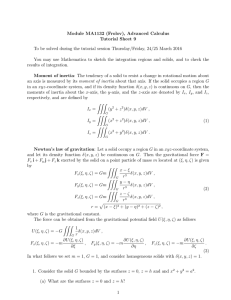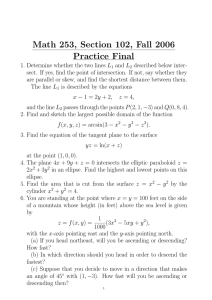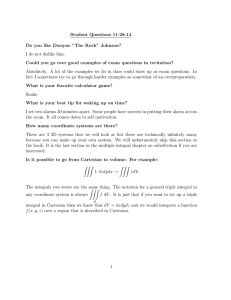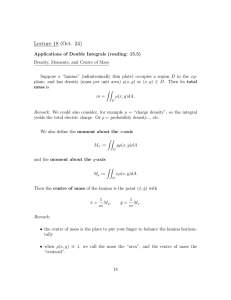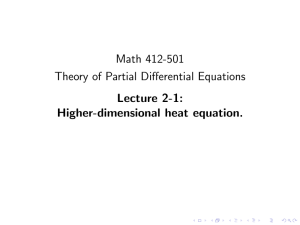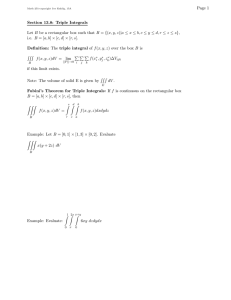1.3 Kinematic transport theorem
advertisement
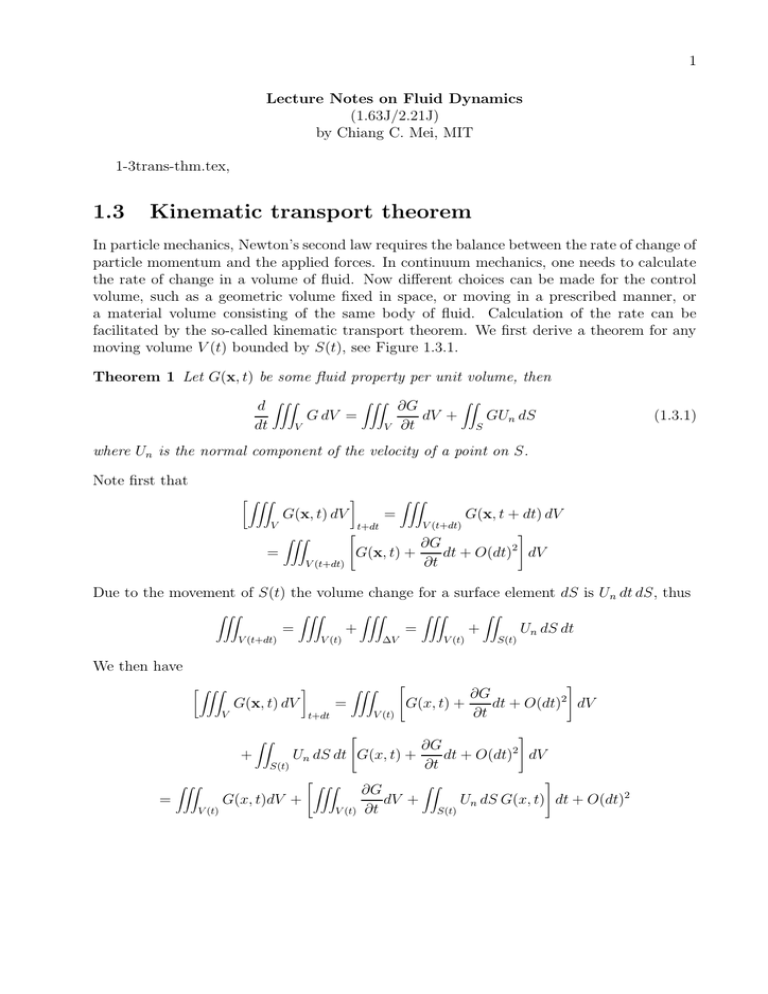
1 Lecture Notes on Fluid Dynamics (1.63J/2.21J) by Chiang C. Mei, MIT 1-3trans-thm.tex, 1.3 Kinematic transport theorem In particle mechanics, Newton’s second law requires the balance between the rate of change of particle momentum and the applied forces. In continuum mechanics, one needs to calculate the rate of change in a volume of fluid. Now different choices can be made for the control volume, such as a geometric volume fixed in space, or moving in a prescribed manner, or a material volume consisting of the same body of fluid. Calculation of the rate can be facilitated by the so-called kinematic transport theorem. We first derive a theorem for any moving volume V (t) bounded by S(t), see Figure 1.3.1. Theorem 1 Let G(x, t) be some fluid property per unit volume, then ZZZ ZZ ∂G d ZZZ G dV = dV + GUn dS dt V V ∂t S (1.3.1) where Un is the normal component of the velocity of a point on S. Note first that ZZZ V = G(x, t) dV ZZZ " V (t+dt) = t+dt ZZZ V (t+dt) G(x, t + dt) dV # ∂G G(x, t) + dt + O(dt)2 dV ∂t Due to the movement of S(t) the volume change for a surface element dS is Un dt dS, thus ZZZ V (t+dt) = ZZZ V (t) + ZZZ ∆V = ZZZ V (t) + ZZ Un dS dt S(t) We then have ZZZ G(x, t) dV V + = ZZZ V (t) ZZ = t+dt ZZZ V (t) " # ∂G G(x, t) + dt + O(dt)2 dV ∂t " # ∂G Un dS dt G(x, t) + dt + O(dt)2 dV ∂t S(t) G(x, t)dV + "ZZZ V (t) ∂G dV + ∂t ZZ S(t) # Un dS G(x, t) dt + O(dt)2 2 Figure 1.3.1: A moving volume in the fluid Since d dt ZZZ G dV = V ZZZ G(x, t) dV V − t+dt ZZZ V (t) G(x, t)dt (1.3.1) is proven. If V (t) is a material volume containing the same moving fluid particles, then, Un = q · n and d/dt is the material derivative. We then have as a corollary, the following Theorem 2 If V (t) is a material volume, ZZZ ZZ D ZZZ ∂G G dV = dV + Gq · n dS Dt V V ∂t S (1.3.2) This is the kinematic transport theorem. Let us apply this theorem to derive certain differential conservation laws. 1.3.1 Transport of Mass Let G = ρ = density and V (t) be a material volume within which there are no mass sources or sinks, then by mass conservation, D Dt ZZZ V (t) ρdV = 0 3 by mass conservation. Using (1.3.2) we get ZZZ V ZZZ ∂ρ ZZ + ρq · ndS = ∂t S V ! ∂ρ + ∇ · (ρq) dV = 0 ∂t (1.3.3) Because V is arbitrary the integrand must vanish identically : ∂ρ + ∇ · (ρq) = 0 ∂t (1.3.4) This is the differential form of mass conservation law, valid at any point inside the fluid. As an alternate form we may write dρ ∂ρ + q · ∇ρ + ρ∇ · q = + ρ∇ · q = 0 ∂t dt (1.3.5) For the special case of an incompressible but non homogeneous fluid: Dρ ∂ρ = + q · ∇ρ = 0 Dt ∂t (1.3.6) ∇·q=0 (1.3.7) It follows that which is also known as the continuity equation. If the incompressible fluid is also homogeneous, then (1.3.7) holds and ρ = constant (1.3.8) replaces (1.3.6). Do avoid the common error of assuming incompressible fluid as being homogeneous. 1.3.2 Transport of any dynamical property Let G = ρF where F is some fluid-dynamic property per unit mass, and V is a material volume, then, ZZZ ZZZ D DF ρF dV = ρ (1.3.9) Dt Dt V V Thus, the total derivative can pass through the integral sign and ρ. From (1.3.2) D Dt ZZZ V ρF dV ∂ρF = dV + ρF q · ndS V ∂t S ! ZZZ ∂ρ ∂F = F +ρ + ∇ · (ρqF ) dV ∂t ∂t V # " #) ZZZ ( " ∂ρ ∂F = F + ∇ · (ρq) + ρ + q · ∇F dV ∂t ∂t V ZZZ DF = ρ Dt V ZZZ ZZ 4 after using the law of mass conservation (1.3.5). As a special case the rate of momentum transport in a fluid volume V is found by taking G = ρq, then, ZZZ ZZZ Dq D ρqf dV = ρ dV (1.3.10) Dt Dt V V which will be used later.

